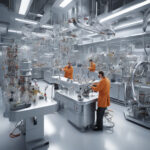Flying Taxi Engines Produce Weird Sound, but Scientists Have Found a Fix
Ever wonder why some machines just sound so horrible, not just loud, but truly irritating? The sound of flying taxi engines falls into this category for many people. The high-pitched whine and strange vibrations have been a cause of concern for both passengers and engineers alike. However, there is good news on the horizon. Scientists have recently discovered a groundbreaking fix that could revolutionize the way we perceive these futuristic modes of transportation.
The development of flying taxis represents a significant leap forward in the field of transportation. These vehicles promise to reduce traffic congestion, lower carbon emissions, and provide a faster means of travel in urban areas. However, one major drawback has been the noise produced by their engines. The sound has been described as akin to a swarm of angry bees or a high-pitched squeal that can be heard from blocks away.
This unpleasant noise is not just a nuisance; it can also have negative effects on human health. Studies have shown that exposure to loud and irritating sounds can lead to increased stress levels, disturbed sleep, and even hearing loss. In densely populated urban areas where flying taxis are expected to operate, mitigating this noise pollution is crucial for their widespread acceptance and success.
Fortunately, a team of scientists working in collaboration with leading aviation companies has made a breakthrough in addressing this issue. By studying the aerodynamics of flying taxi engines and analyzing the frequencies of the sounds they produce, they have identified the root cause of the problem. It turns out that the unique design of these engines, while efficient in terms of propulsion, also generates acoustic vibrations that contribute to the unpleasant noise.
To tackle this issue, the scientists have proposed a simple yet effective solution: the implementation of specially designed sound-absorbing materials within the engine components. These materials, which have been tested extensively in laboratory settings, have shown promising results in reducing the overall noise levels produced by the engines. The use of these materials does not compromise the performance or efficiency of the engines, making it a win-win solution for all parties involved.
The implications of this discovery are far-reaching. Not only does it pave the way for a more pleasant flying experience for passengers and residents alike, but it also sets a new standard for noise reduction in aviation technology. As flying taxis continue to gain popularity and become a more common sight in urban skies, ensuring their acoustic comfort will be paramount to their integration into existing transportation systems.
In conclusion, the issue of weird sounds produced by flying taxi engines is being addressed head-on by a dedicated team of scientists and engineers. Their innovative use of sound-absorbing materials represents a significant step forward in improving the overall experience of this mode of transportation. With these advancements, flying taxis are poised to become not only a convenient and efficient way to travel but also a quiet and peaceful addition to our urban landscapes.
flying taxis, engine noise, sound-absorbing materials, urban transportation, aviation technology












